

Compact Muon Solenoid
LHC, CERN
| CMS-PAS-HIN-19-008 | ||
| Search for strong electromagnetic fields in PbPb collisions at 5.02 TeV via azimuthal anisotropy of D0 and ¯D0 mesons | ||
| CMS Collaboration | ||
| November 2019 | ||
| Abstract: Motivated by the search for strong electromagnetic fields created in PbPb collisions, the first measurement of the v2 difference (Δv2) between D0 and ¯D0 is presented as a function of rapidity. The result for the rapidity-averaged v2 difference is found to be <Δv2>= 0.001 ± 0.001 (stat) ± 0.003 (syst), consistent with zero within experimental uncertainties. Comparisons with models may help to directly constrain the electric conductivity of the hot and dense medium formed in these collisions. Measurements of flow harmonics of D0 (ˉuc) and ¯D0 (uˉc) mesons are presented as functions of rapidity (y), transverse momentum (pT), and collision centrality, for PbPb collisions at 5.02 TeV, using data collected by the CMS experiment during the 2018 LHC run. The results improve previous ones published by CMS, by extending the pT coverage and providing more differential information. A clear centrality dependence of prompt D0 v2 is observed, while v3 is largely independent of centrality. The trend is consistent with expectations of flow driven by the initial-state geometry. No significant rapidity dependence of prompt ¯D0 v2 and v3 is observed. | ||
|
Links:
CDS record (PDF) ;
CADI line (restricted) ;
These preliminary results are superseded in this paper, PLB 816 (2021) 136253. The superseded preliminary plots can be found here. |
||
| Figures | |
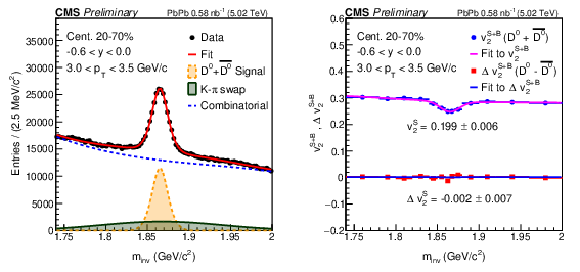
png pdf |
Figure 1:
Simultaneous fit on mass spectrum and v2 (Δv2) as function of invariant mass for 3.0 <pT< 3.5 GeV/c, centrality 20-70% and −0.6<y<0.0. |
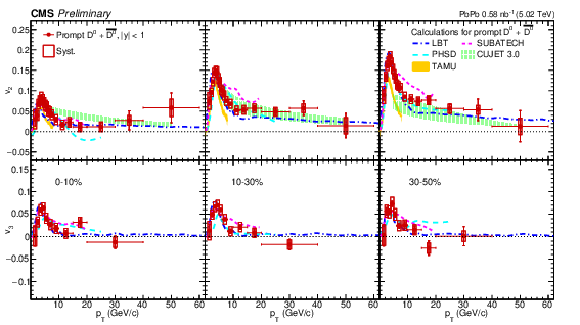
png pdf |
Figure 2:
Prompt D0 meson v2 (top) and v3 (bottom) coefficients at midrapidity (|y|<1) for the centrality classes 0-10% (left), 10-30% (middle), and 30-50% (right). The vertical bars represent statistical uncertainties and open boxes represent the systematic uncertainties. Theoretical calculations for vn coefficient of prompt D0 mesons are also plotted for comparison. |
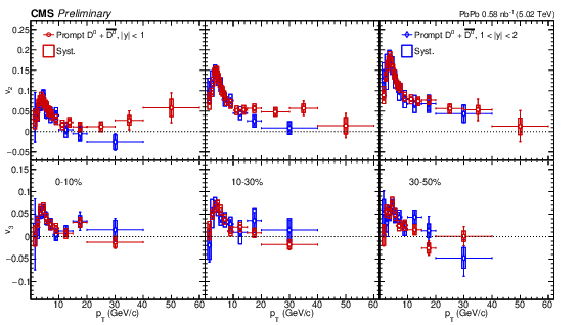
png pdf |
Figure 3:
Prompt D0 meson v2 (top) and v3 (bottom) coefficients at midrapidity (|y|<1) and forward rapidity (1<|y|<2) for the centrality classes 0-10% (left), 10-30% (middle), and 30-50% (right). The vertical bars represent statistical uncertainties and open boxes represent the systematic uncertainties. |
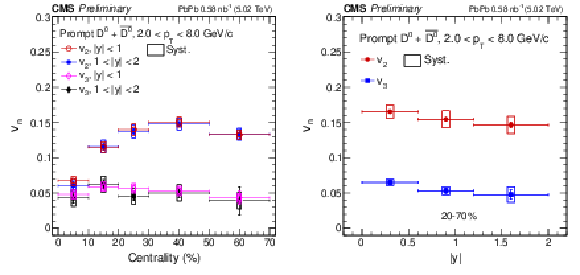
png pdf |
Figure 4:
Prompt D0 meson v2 and v3 as functions of centrality, for 2.0 <pT< 8.0 GeV/c and for rapidity ranges |y|< 1 and 1 <|y|< 2 (left). Prompt D0 v2 and v3 as function of rapidity, for 2.0 <pT< 8.0 GeV/c and for centrality 20-70% (right). The vertical bars represent statistical uncertainties and open boxes represent the systematic uncertainties. |
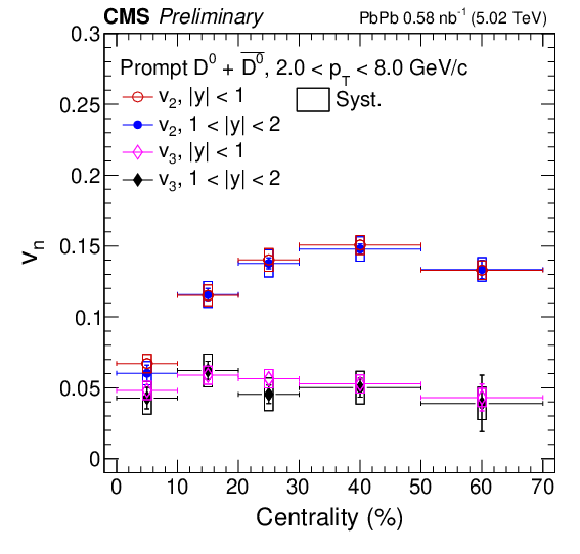
png pdf |
Figure 4-a:
Prompt D0 meson v2 and v3 as functions of centrality, for 2.0 <pT< 8.0 GeV/c and for rapidity ranges |y|< 1 and 1 <|y|< 2. The vertical bars represent statistical uncertainties and open boxes represent the systematic uncertainties. |
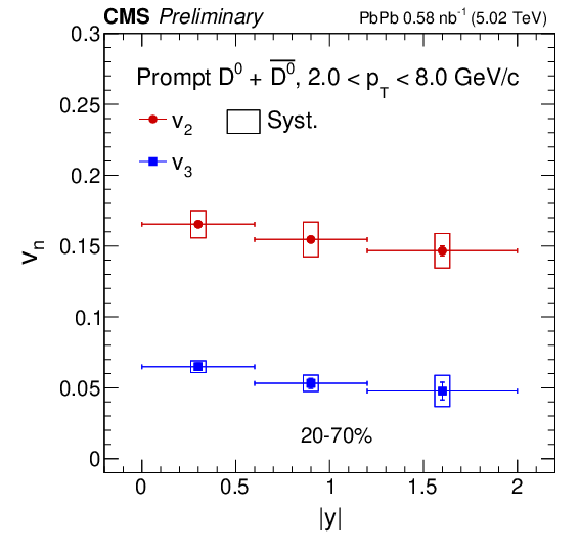
png pdf |
Figure 4-b:
Prompt D0 v2 and v3 as function of rapidity, for 2.0 <pT< 8.0 GeV/c and for centrality 20-70%. The vertical bars represent statistical uncertainties and open boxes represent the systematic uncertainties. |
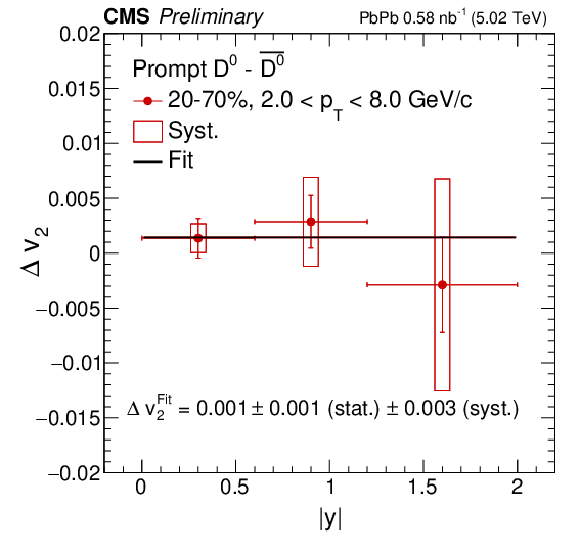
png pdf |
Figure 5:
Prompt D0 meson Δv2 as a function of rapidity, for 2.0 <pT< 8.0 GeV/c and centrality 20-70%. The vertical bars represent statistical uncertainties and open boxes represent the systematic uncertainties. |
| Tables | |

png pdf |
Table 1:
Summary of systematic uncertainties for v2. Ranges of variation of uncertainties for each binning are presented. The cells filled with "−'' refer to the cases where no estimate of uncertainty is required for the source or where the uncertainty cancels out. |

png pdf |
Table 2:
Summary of systematic uncertainties for v3. Ranges of variation of uncertainties for each binning are presented. The cells filled with "−'' refer to the cases where no estimate of uncertainty is required for the source or where the uncertainty cancels out. |

png pdf |
Table 3:
Summary of systematic uncertainties for Δv2. Ranges of variation of uncertainties for each binning are presented. The cells filled with "−'' refer to the cases where no estimate of uncertainty is required for the source or where the uncertainty cancels out. |
| Summary |
| New measurements of prompt D0 mesons elliptic (v2) and triangular (v3) flow are presented as a function of pT, rapidity and collision centrality, in PbPb collisions at √sNN= 5.02 TeV. The results improve previously published CMS data by extending the pT coverage and by providing more differential information. A clear centrality dependency of prompt D0 v2 is observed, while v3 is largely centrality independent. The trend is consistent with the expectation of a centrality dependency driven by initial-state geometry. No significant rapidity dependency of prompt D0 v2 and v3 is observed, although possible dependency on rapidity cannot be discarded. When comparing against various theoretical calculations at midrapidity, no model is able to describe the data over the full centrality and pT ranges. Motivated by the search for a strong electric field possibly created in PbPb collisions, a first measurement of the v2 difference (Δv2) between D0 and ¯D0 as a function of rapidity is presented. The rapidity-averaged v2 difference is measured to be <Δv2>= 0.001 ± 0.001 (stat) ± 0.003 (syst), consistent with zero within the experimental uncertainties, indicating that no effect of electric field on charm hadron collective flow is observed. Future model comparisons may provide constraints on the electric conductivity of the QGP medium. |
| References | ||||
| 1 | BRAHMS Collaboration | Quark gluon plasma and color glass condensate at RHIC? The Perspective from the BRAHMS experiment | NP A 757 (2005) 1 | arXiv:nucl-ex/0410020 |
| 2 | PHOBOS Collaboration | The PHOBOS perspective on discoveries at RHIC | NP A 757 (2005) 28 | arXiv:nucl-ex/0410022 |
| 3 | STAR Collaboration | Experimental and theoretical challenges in the search for the quark gluon plasma: The STAR Collaboration's critical assessment of the evidence from RHIC collisions | NP A 757 (2005) 102 | arXiv:nucl-ex/0501009 |
| 4 | PHENIX Collaboration | Formation of dense partonic matter in relativistic nucleus-nucleus collisions at RHIC: Experimental evaluation by the PHENIX collaboration | NP A 757 (2005) 184 | arXiv:nucl-ex/0410003 |
| 5 | ALICE Collaboration | Elliptic flow of charged particles in Pb-Pb collisions at 2.76 TeV | PRL 105 (2010) 252302 | 1011.3914 |
| 6 | ATLAS Collaboration | Measurement of the pseudorapidity and transverse momentum dependence of the elliptic flow of charged particles in lead-lead collisions at √sNN= 2.76 TeV with the ATLAS detector | PLB 707 (2012) 330 | 1108.6018 |
| 7 | CMS Collaboration | Measurement of the elliptic anisotropy of charged particles produced in PbPb collisions at √sNN= 2.76 TeV | PRC 87 (2013) 014902 | CMS-HIN-10-002 1204.1409 |
| 8 | J.-Y. Ollitrault | Determination of the reaction plane in ultrarelativistic nuclear collisions | PRD 48 (1993) 1132 | hep-ph/9303247 |
| 9 | S. Voloshin and Y. Zhang | Flow study in relativistic nuclear collisions by Fourier expansion of azimuthal particle distributions | Z. Phys. C 70 (1994) 665 | hep-ph/9407282 |
| 10 | A. M. Poskanzer and S. A. Voloshin | Methods for analyzing anisotropic flow in relativistic nuclear collisions | PRC 58 (1998) 1671 | arXiv:nucl-ex/9805001 |
| 11 | P. Braun-Munzinger | Quarkonium production in ultra-relativistic nuclear collisions: Suppression versus enhancement | JPG 34 (2007) S471 | arXiv:nucl-th/0701093 |
| 12 | F.-M. Liu and S.-X. Liu | Quark-gluon plasma formation time and direct photons from heavy ion collisions | PRC 89 (2014) 034906 | arXiv:nucl-th/1212.6587 |
| 13 | U. Gursoy et al. | Charge-dependent Flow Induced by Magnetic and Electric Fields in Heavy Ion Collisions | PRC 98 (2018) 055201 | 1806.05288 |
| 14 | S. K. Das et al. | Directed Flow of Charm Quarks as a Witness of the Initial Strong Magnetic Field in Ultra-Relativistic Heavy Ion Collisions | PLB 768 (2017) 260 | arXiv:nucl-th/1608.02231 |
| 15 | S. Chatterjee and P. Bozek | Large directed flow of open charm mesons probes the three dimensional distribution of matter in heavy ion collisions | PRL 120 (2018) 192301 | 1712.01189 |
| 16 | STAR Collaboration | Elliptic flow from two and four particle correlations in Au+Au collisions at s(NN)**(1/2) = 130-GeV | PRC 66 (2002) 034904 | arXiv:nucl-ex/0206001 |
| 17 | M. Luzum and J.-Y. Ollitrault | Eliminating experimental bias in anisotropic-flow measurements of high-energy nuclear collisions | PRC 87 (2013) 044907 | arXiv:nucl-ex/1209.2323 |
| 18 | A. Hoecker et al. | TMVA: Toolkit for Multivariate Data Analysis | PoS ACAT (2007) 040 | physics/0703039 |
| 19 | CMS Collaboration | Measurement of prompt D0 meson azimuthal anisotropy in Pb-Pb collisions at √sNN= 5.02 TeV | PRL 120 (2018) 202301 | CMS-HIN-16-007 1708.03497 |
| 20 | CMS Collaboration | Description and performance of track and primary-vertex reconstruction with the CMS tracker | JINST 9 (2014) P10009 | CMS-TRK-11-001 1405.6569 |
| 21 | CMS Collaboration | The CMS experiment at the CERN LHC | JINST 3 (2008) S08004 | CMS-00-001 |
| 22 | CMS Collaboration | Charged-particle nuclear modification factors in PbPb and pPb collisions at √sNN= 5.02 TeV | JHEP 04 (2017) 039 | CMS-HIN-15-015 1611.01664 |
| 23 | T. Sjostrand et al. | An Introduction to PYTHIA 8.2 | CPC 191 (2015) 159 | 1410.3012 |
| 24 | CMS Collaboration | Extraction and validation of a new set of CMS PYTHIA8 tunes from underlying-event measurements | CMS-GEN-17-001 1903.12179 |
|
| 25 | I. P. Lokhtin and A. M. Snigirev | A Model of jet quenching in ultrarelativistic heavy ion collisions and high-p(T) hadron spectra at RHIC | EPJC 45 (2006) 211 | hep-ph/0506189 |
| 26 | Particle Data Group Collaboration | Review of Particle Physics | PRD 98 (2018) 030001 | |
| 27 | NA49 Collaboration | Directed and elliptic flow of charged pions and protons in Pb + Pb collisions at 40-A-GeV and 158-A-GeV | PRC 68 (2003) 034903 | nucl-ex/0303001 |
| 28 | CMS Collaboration | Azimuthal anisotropy of charged particles with transverse momentum up to 100 GeV/ c in PbPb collisions at √sNN= 5.02 TeV | PLB 776 (2018) 195 | CMS-HIN-15-014 1702.00630 |
| 29 | S. Cao, T. Luo, G.-Y. Qin, and X.-N. Wang | Linearized Boltzmann transport model for jet propagation in the quark-gluon plasma: Heavy quark evolution | PRC 94 (2016) 014909 | 1605.06447 |
| 30 | J. Xu, J. Liao, and M. Gyulassy | Bridging Soft-Hard Transport Properties of Quark-Gluon Plasmas with CUJET3.0 | JHEP 02 (2016) 169 | 1508.00552 |
| 31 | M. Nahrgang et al. | Elliptic and triangular flow of heavy flavor in heavy-ion collisions | PRC 91 (2015) 014904 | 1410.5396 |
| 32 | M. He, R. J. Fries, and R. Rapp | Heavy Flavor at the Large Hadron Collider in a Strong Coupling Approach | PLB 735 (2014) 445 | 1401.3817 |

|
Compact Muon Solenoid LHC, CERN |

|

|

|

|

|

|